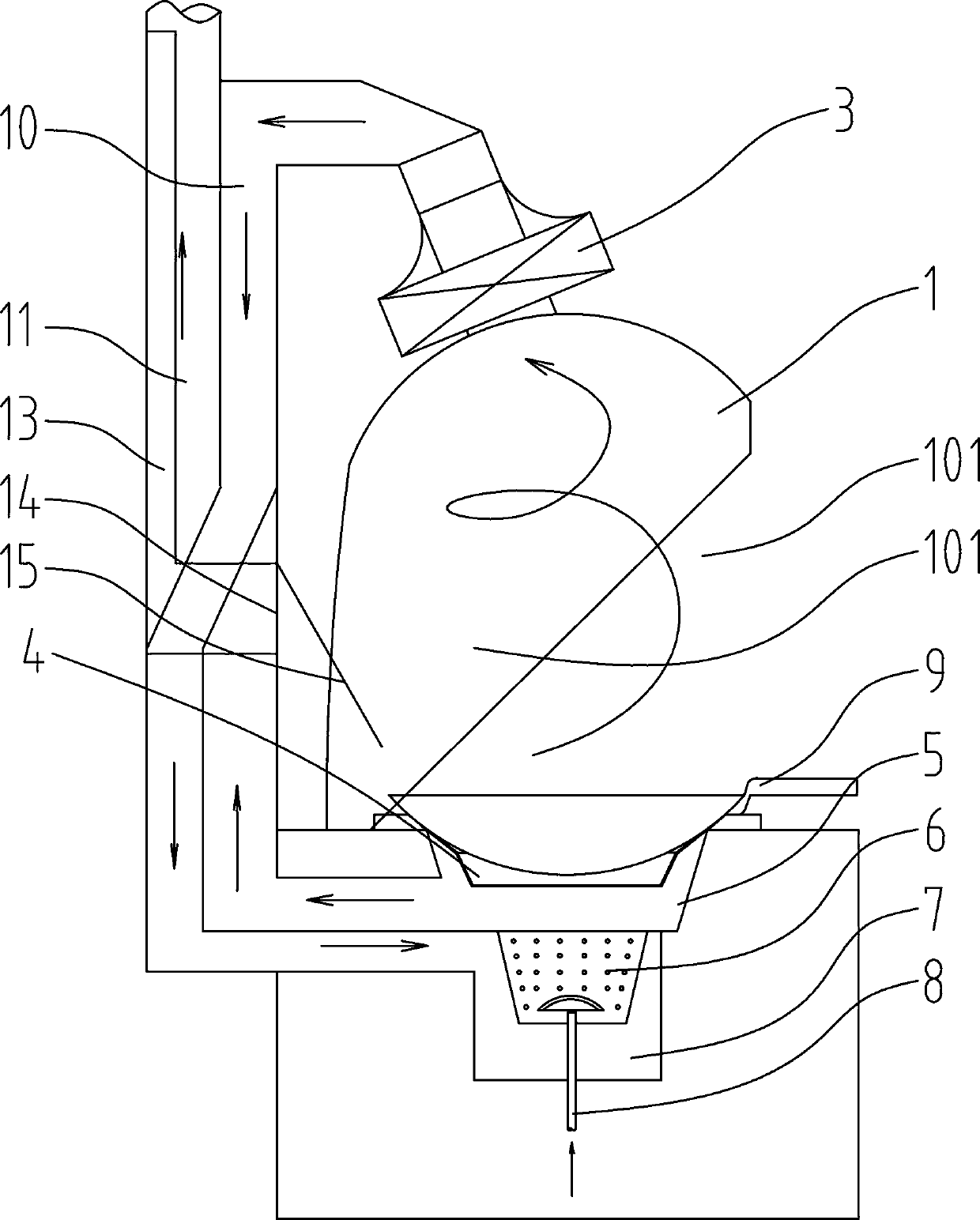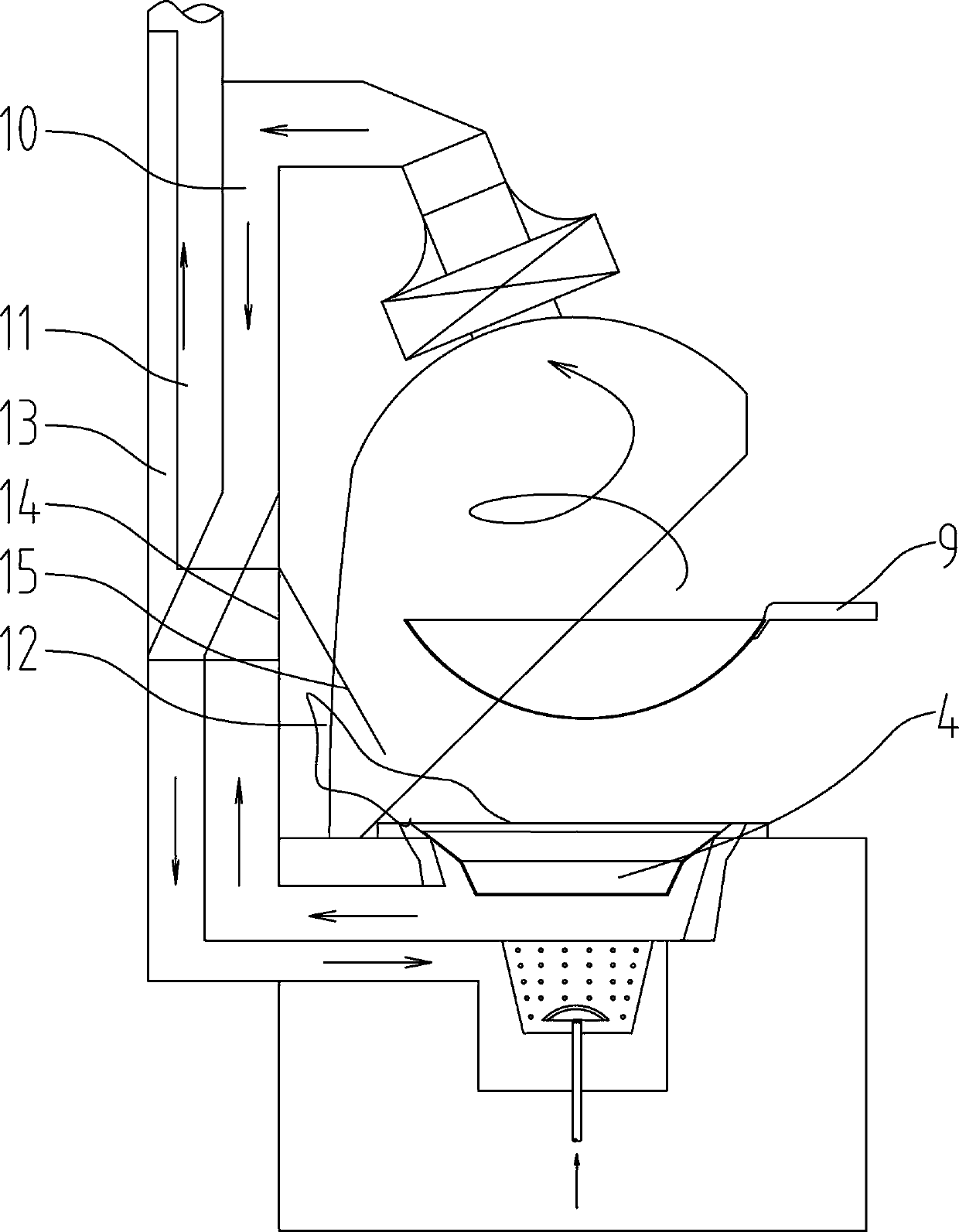Flame-proof structure for stove topping pot
A pot-turning and flame-proof technology, which is applied to household stoves/stoves, incinerators, household stoves, etc., can solve problems such as the inability to discharge the smoke from the fire channel, the escape of flames and smoke, and the backflow of the fire channel.
- Summary
- Abstract
- Description
- Claims
- Application Information
AI Technical Summary
Problems solved by technology
Method used
Image
Examples
Embodiment 1
[0031] like Figures 1~3 Among them, a stove topping pot flameproof structure, comprising a stove body 2, a furnace is provided in the stove body 2, a smoke hood 1 is arranged above the furnace, a fire vent 14 is provided at the back of the smoke hood 1, and a fire vent 14 connected to the chimney. With this structure, during the process of the operator turning the pot, the flame ejected from the furnace is attracted by the fire vent 14, which will not affect the operator's operation.
[0032] The preferred solution is as figure 2 , 3 Among them, a fire deflector 15 inclined downward is provided above the fire vent 14;
[0033] The bottom of the fire guide plate 15 is located near the upper end of the furnace, away from the operator's side. With this structure, it is convenient to guide the flame into the fire vent 14, and it is possible to separate the flame from the oil fume, so as to avoid the untreated discharge of the oil fume.
Embodiment 2
[0035] On the basis of the above examples, the preferred scheme is as Figures 1~5 Among them, a flame guide device 4 is provided between the top of the furnace and the pot 9, the space between the furnace hearth and the flame guide device 4 communicates with the chimney, and a recess 42 is provided on the flame guide device 4, and the recess 42 is connected to the pot 9. A cavity structure is formed between the bottoms, and a fire hole 43 or a fire grill 45 is provided in the recessed part 42 . With this structure, the cavity structure between the recessed portion 42 and the bottom of the pot 9 maintains a positive pressure all the time, and the flame can be prevented from erupting toward the operator, thereby overcoming the influence of the pot upset on the operator. It should be noted that in the prior art, there is also a scheme of controlling the gas output to make the flame smaller when the pot is turned upside down, but this scheme makes it difficult to realize the oper...
Embodiment 3
[0044] On the basis of the above examples, the preferred scheme is as Figures 1~3 Among them, the hood 1 is provided with a back side and a side wall 102 of the hood, the back of the hood 1 is connected with the back of the stove body 2, the top of the hood 1 is provided with a hood dome 103, and the top of the hood 103 is The position is connected with exhaust fan 3. With this structure, when the exhaust fan 3 is started, the oxygen supply air enters into the fume hood 1 from the air inlet 101 in the atmospheric environment under negative pressure conditions. Greatly improve the efficiency of oil fume collection.
[0045] In a preferred solution, the distance between the side wall 102 of the fume hood and the stove body 2 is 0-40 cm. Specifically, the distance between the bottom of the side wall 102 of the plane, arc or nearly circular surface of the smoke hood 1 and the stove body table 22 of the stove body 2 is 0-40 cm, preferably 0-20 cm, and more preferably 0 to 10 cm...
PUM
 Login to View More
Login to View More Abstract
Description
Claims
Application Information
 Login to View More
Login to View More - R&D
- Intellectual Property
- Life Sciences
- Materials
- Tech Scout
- Unparalleled Data Quality
- Higher Quality Content
- 60% Fewer Hallucinations
Browse by: Latest US Patents, China's latest patents, Technical Efficacy Thesaurus, Application Domain, Technology Topic, Popular Technical Reports.
© 2025 PatSnap. All rights reserved.Legal|Privacy policy|Modern Slavery Act Transparency Statement|Sitemap|About US| Contact US: help@patsnap.com



